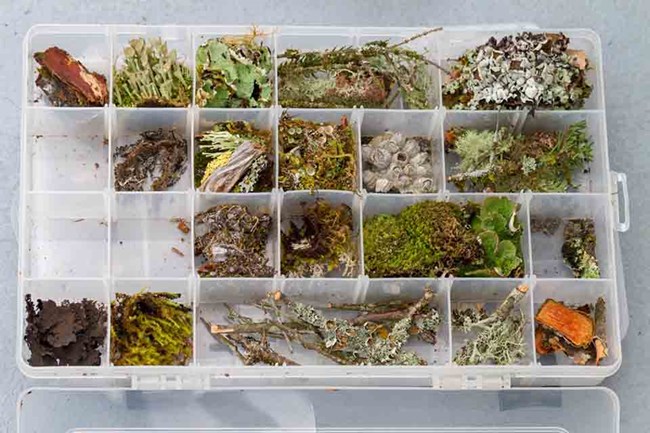Last updated: October 13, 2018
Article
Lichen Biodiversity

NPS/James Walton
Lichens are a major component of high-latitude ecosystems and are highly sensitive to environmental conditions, including airborne contaminants, substrate chemistry, and climate. Such attributes make them useful indicators of species richness, air quality, and climate. Although ecologically important, lichens have until recently been a poorly known component within the two largest parks of the I&M Program’s Southwest Alaska Network (SWAN).
Collaborators from Oregon State University, several universities in Europe and North America, and SWAN have now published a paper in the journal Mycosphere that presents detailed findings from the SWAN lichen inventory project. The authors report a total of 896 taxa of lichens from Katmai and Lake Clark, adding 889 taxa to the total of seven taxa previously reported in NPSpecies. This list includes ten species new to science, which were recently published elsewhere. An additional 15 lichenicolous fungi (fungi growing on lichens), and seven fungi associated with young living twigs of particular host species are also reported. Seventeen species are new to Alaska, and six species are new to North America (Caloplaca fuscorufa, Lecanora leucococca s.l., Ochrolechia brodoi, Protoparmelia memnonia, Rhizocarpon leptolepis, and Rhizocarpon sinense). Four new species combinations (i.e., updated species names) are presented, Cetraria minuscula, Enchylium millegranum var. bachmanianum, Lathagrium undulatum var. granulosum, and Protomicarea alpestris. New populations of the globally endangered boreal felt lichen, Erioderma pedicillatum, were also discovered in both parks. Of the 64 lichen species currently listed as “rare” by the Alaska Center for Conservation Science, 30% (19) were discovered in the two parks. Of these, 15 were found in Katmai and 16 in Lake Clark.
The rich assemblage of lichen species encountered during the SWAN inventory reflects an interesting biogeographic convergence, with a blend of oceanic species typical of the Pacific Northwest, Arctic and boreal species that occur across the continent, and potentially a Beringian element. Nitrophilous, or nitrogen-loving, species (e.g., Caloplaca, Xanthoria) did not appear to be abundant in either park, suggesting low levels of nitrogenous pollutants. Additionally, few calciphiles, or species showing an affinity for calcium-rich substrates, were encountered, owing to the predominantly acidic rocks in both parks.
To date, fourteen peer-reviewed journal articles and one master’s thesis have been published using inventory findings. Results from these inventories will provide baseline data on lichen occurrence that may be used in resource condition assessments, vulnerability assessments, long-term ecological monitoring, and resource management. Specimens collected during the course of the inventory will be provided on loan to the Museum of the North Herbarium, University of Alaska, and several other institutions, where they will be available for research and educational purposes.
Biodiversity and ecology of lichens of Katmai and Lake Clark National Parks and Preserves, Alaska
Abstract
We inventoried lichens in Lake Clark and Katmai national parks and preserves. We assembled the known information on lichens in these parks by combining field, herbarium, and literature studies. Our results provide baseline data on lichen occurrence that may be used in resource condition assessments, vulnerability assessments, long-term ecological monitoring, and resource management. We report a total of 896 taxa of lichenized fungi from the parks, adding 889 taxa to the total of seven taxa reported for the parks by the National Park Service database and including ten new species first published elsewhere. An additional 15 lichenicolous fungi are reported here. Seven non-lichenized fungi associated with young living twigs of particular host species are also included. Sixteen species are new to Alaska, and six species new to North America (Caloplaca fuscorufa, Lecanora leucococca s.l., Ochrolechia brodoi, Protoparmelia memnonia, and Rhizocarpon leptolepis). Four new combinations are made, Cetraria minuscula, Enchylium millegranum var. bachmanianum, Lathagrium undulatum var. granulosum, and Protomicarea alpestris. Additional new species based on collections from the parks have been described in separate publications.
McCune B, ... Walton J. 2018. Biodiversity and ecology of lichens of Katmai and Lake Clark National Parks and Preserves, Alaska. Mycosphere 9(4):859–930, Doi 10.5943/mycosphere/9/4/10
